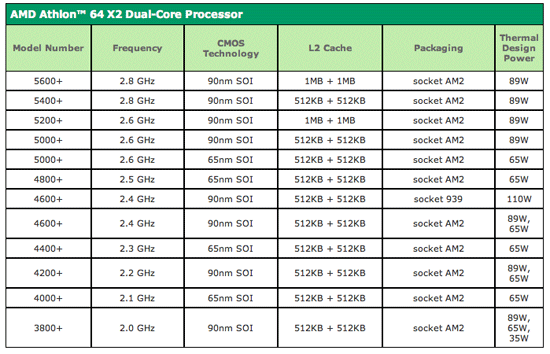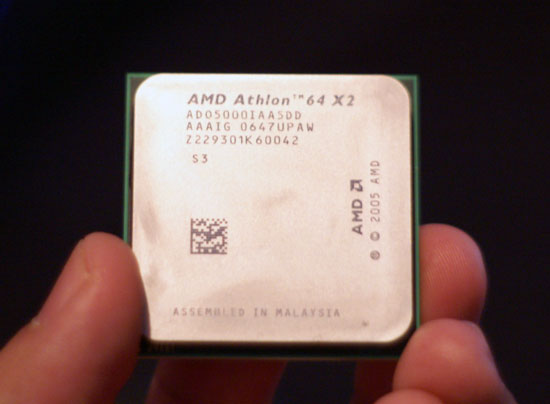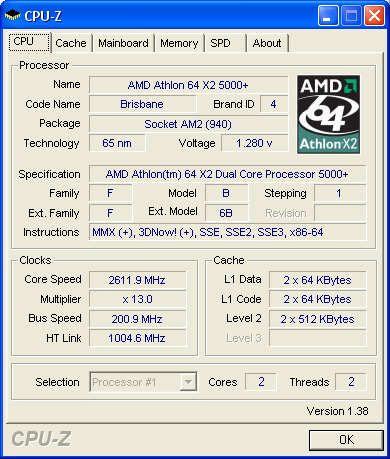AMD's 65nm Brisbane Core Previewed: The most energy efficient AMD CPU to date
by Anand Lal Shimpi on December 14, 2006 6:08 PM EST- Posted in
- CPUs
When Intel launched its Core 2 line of processors we saw AMD's performance and power advantages vanish into thin air but the comparison, at least on the power side, wasn't totally fair. Intel had been shipping desktop processors on its 65nm process for months prior to the launch of Core 2, while AMD's Athlon 64 X2s were still built on a 90nm process. We had no way of telling how much of Intel's power advantage was due to a more efficient architecture or simply smaller, cooler running transistors. Up to now, AMD has been penalized twice in all Core 2 vs. Athlon 64 X2 comparisons; AMD's new micro-architecture won't debut until next year and neither will 65nm in any great quantities.
Technically in-line with roadmaps, AMD just introduced and announced shipment of its first 65nm cores: codenamed Brisbane. Availability is another story entirely, as it's looking like we won't see any real quantities of these things until Q1 2007. Right now AMD's Brisbane chips are strictly OEM only and AMD wasn't able to give us an indication of when to expect retail/channel availability. Of course we wouldn't be talking about this today if we didn't have a chip, which we do, but for all intents and purposes you can consider this a preview of what to expect in the new year from AMD's first 65nm chips.
AMD announced its Brisbane lineup earlier this month, the chips and basic specs are listed below:

As you can expect, AMD is pricing the 65nm chips in line with its 90nm offerings to encourage the transition. Die size and TDP have both gone down to 126 mm^2 and 65W across the line. As AMD improves its 65nm SOI process you can expect to see even lower wattage parts, but for now all of the 65nm chips are rated at 65W TDP.
Transistor count remains unchanged at 154M as there is no new functionality or cache introduced with the move to 65nm. Once again, we will have to wait until around the middle of 2007 before we'll see any major changes to AMD's architecture.

The chip we received was AMD's 65nm Athlon 64 X2 5000+ and from the outside, it looks just like a normal X2. The only way to tell that this is a 65nm chip is by looking at the OPN.

Armed with the chip and its $301 price point we set out to compare its performance, power consumption and power efficiency to AMD's other 90nm CPUs and the closest price competitor from Intel: the Core 2 Duo E6600 priced at $316.










63 Comments
View All Comments
IntelUser2000 - Thursday, December 21, 2006 - link
Looking at PURELY gaming purposes. Faster CPU is ABSOLUTELY USELESS. Face it, majority of the gamers that are considered hardcore doesn't run 2560x1600 resolutions, and it looks like at the resolutions they are running at, 1280x1024 or 1600x1200, it seems getting a faster CPU is worth it.Nope. Why get a faster CPU when you already get 100+ frames per second?? What a video card enables is get higher quality graphics WITHOUT losing performance compared to the lower performing video cards. A CPU does what?? A absolutely useless 20 additional frames onto the already more than enough 100+.
Now we still see reviewers benching systems with 4xAA and 16xAF at ever higher(and ridiculously unreal) resolutions. But we know latest video cards allows super high AA features too. 1600x1200 with 16xAA 64xAF(Ok I forgot what the highest AF was, cut me some slack ok?? Way too many features in new video cards, lost track around X800 time...) sounds pretty good.
esterhasz - Sunday, December 17, 2006 - link
I would have loved to see how low the 65nm parts undervolt...Tujan - Friday, December 15, 2006 - link
Would have been better comparing the 6400 Intel,to a 4600 x2 since these come in to even application performance.Then comparing the 5000 to them both.
Performance per watt is meaningless here.Since the formula (fps/power)is also useless without the baseline.
The 6600 outperforms the 6400 Intel Core Duo.The 5000 x2 outperforms the 4600 x2 AMD.So higher FPS of the higher performing processor is skewed to the formula as well.
I see that your dealing with a range between 15 and 30$ though.
Nobody knows just how well the AMD 5000 x2 does better than the 4600 x2 anyway.
I see you have EEs there AMD (x2).So couldn't go wrong in that effect.Purchasing an AMD 65nm x2 5000(non-extreme).Seeing the 5000 x2 only has 512kbx2 cache.
Long as AMD doesn't put everybody up to those thousand dollar processors.Im ok with them.
coldpower27 - Friday, December 15, 2006 - link
So? That's AMD problem they can't afford to put 4MB of LV2 on their processors. The comparison is what it is processors at equal price points. They only had the 5000+ on hand, so it was compared to the closest processor in price.The 4600+ was only used as it is the highest 65W TDP processor on the 90nm node. It was probably used to see if the 65W TDP was justified on the 5000+ 65nm.
Genx87 - Friday, December 15, 2006 - link
AMD needs a new core and that is the scientific truth!hubajube - Friday, December 15, 2006 - link
I don't know about you'ins. But I give a shit less about Intel's or AMD's or Macy's marketing prowess. I do my own research from my own sources and make decisions based on that. What's an ad? What's a TV commercial? Only the clueless and the lazy need those to guide them in what products to buy or even if the product exists. I don't give a shit about marketing.duploxxx - Friday, December 15, 2006 - link
Nice price comparison... maybe you should also add that for the same future set you get on the mobo there is a price difference of 1/3 in favor of AMD! So put a e6400 in line of this comparison then you have the same price tag!Well we all know oc'ing c2d is for noobs.... you don't need any knowledge...(see it as good or as bad whatever you want)
but oc'ing AMD does require knowledge.
Htt link is on 1125, what do you expect to reach of an oc? on 90nm parts most of the htt link knocked out around 1060-1080, so maybe try to make a decent oc...
And where is a screenshot of the mem and devider when you are oc'ing?
Anand Lal Shimpi - Friday, December 15, 2006 - link
Sorry I should have addressed this in the review - HTT speed had no impact on my overclocking results with this particular chip; even with a HT multiplier of 4X the chip won't get into Windows at 2.99GHz. Memory wasn't a factor as it was set to the lowest speed possible in order to see how far we could push the CPU.I have a feeling that with better air cooling close to 3GHz may be possible, but I wanted to look at the worst case scenario overclocking potential of just using a stock heatsink/fan similar to what we did in our Core 2 overclocking article upon its release.
I'm working on the Brisbane 4800+ now and will find out soon if it overclocks any better.
Take care,
Anand
JarredWalton - Friday, December 15, 2006 - link
OC'ing AMD is pretty simple as well. Just drop the HTT multiplier to 4X if you get above about 220 MHz - not that the total HTT speed generally matters. You can also drop memory dividers if you have less capable RAM. I still think 775 overclocking requires a bit more knowledge/effort - a bit, I said, not a lot! I can't see anyone but an elitist thinking easier OC'ing would be a bad thing, though.duploxxx - Friday, December 15, 2006 - link
why is 775 oc harder, it has one factor less to keep in mind and then i won't speak about the memory options....I've used already a 6600 to play with on an asus board, just left everything to auto, put the fsb to 400 and hey it runned stable on 3600 (depending on your memory offcourse)? WTF you could say on stock vcore? nope the board increased the vcore automatically.... it was running on 1,56 auto :)
Will you update this review due to the htt? or will you leave as lots of you're reviews (like the woodrcest testing) saying that some more test are comming but eventually nothing changes.... people actually read your reviews and believe them by hard...so accurate review is always welcome....